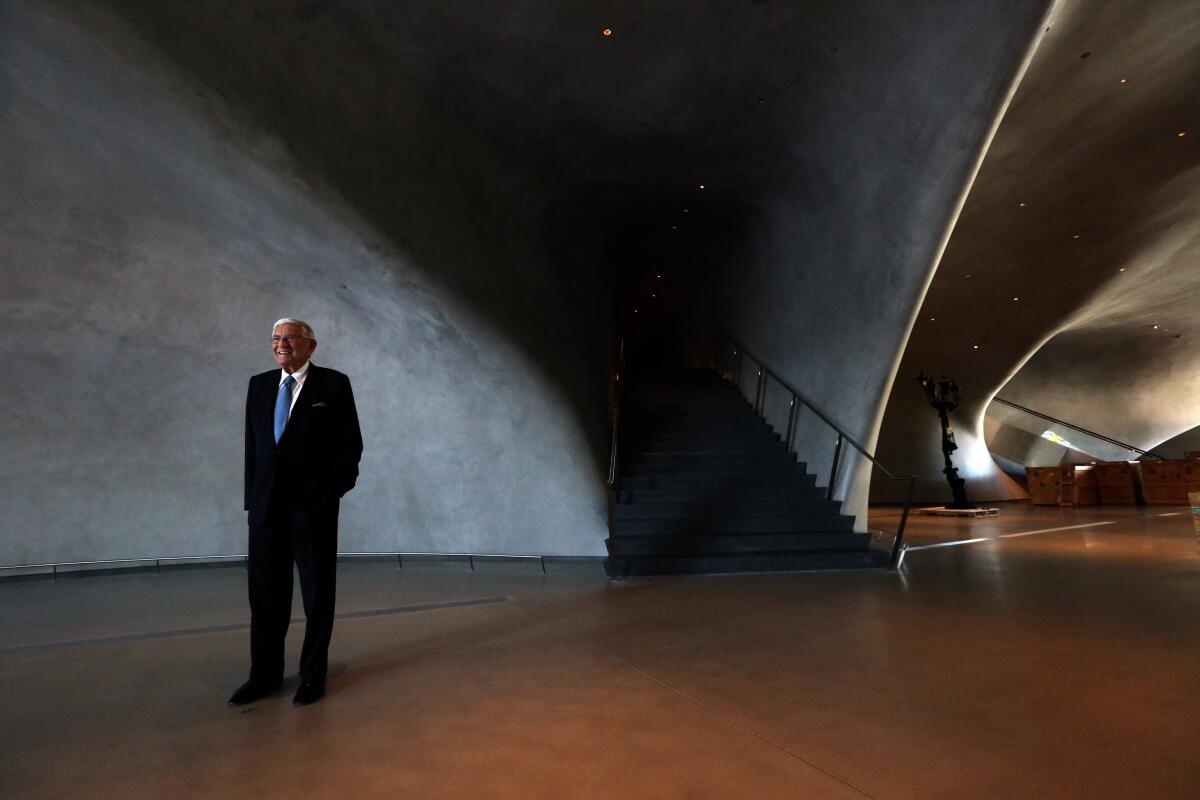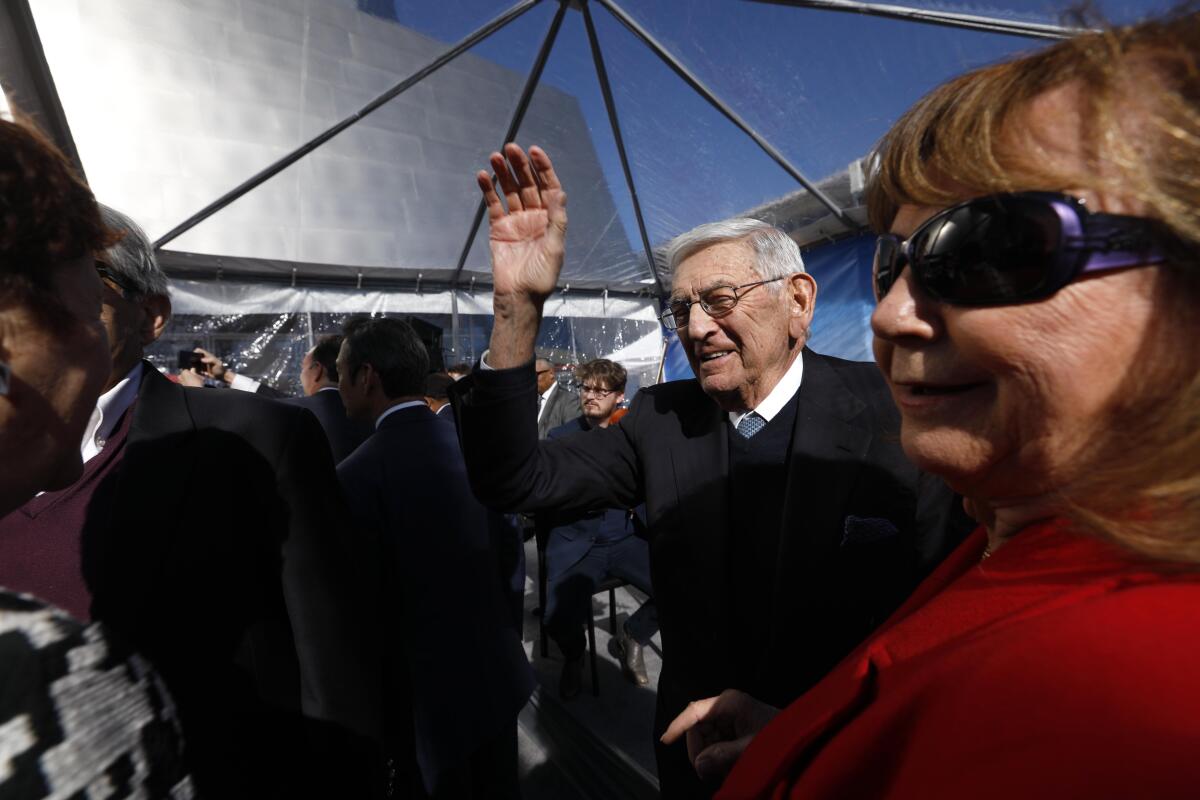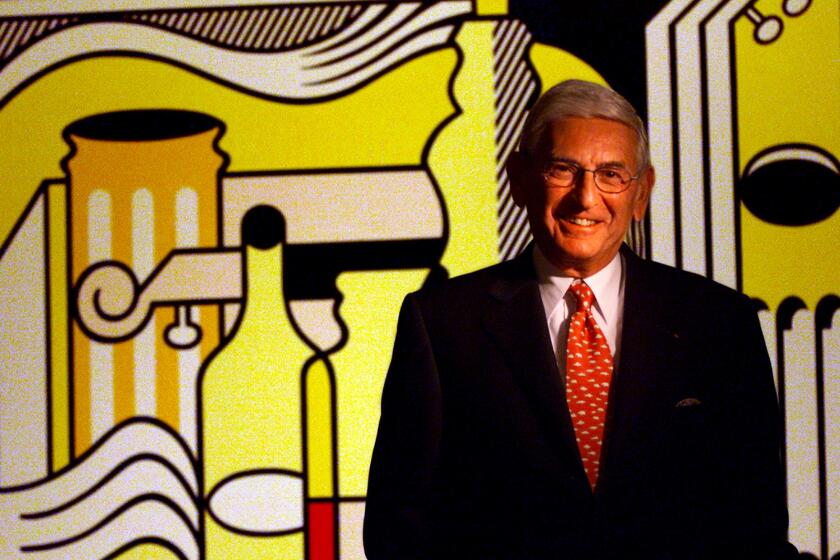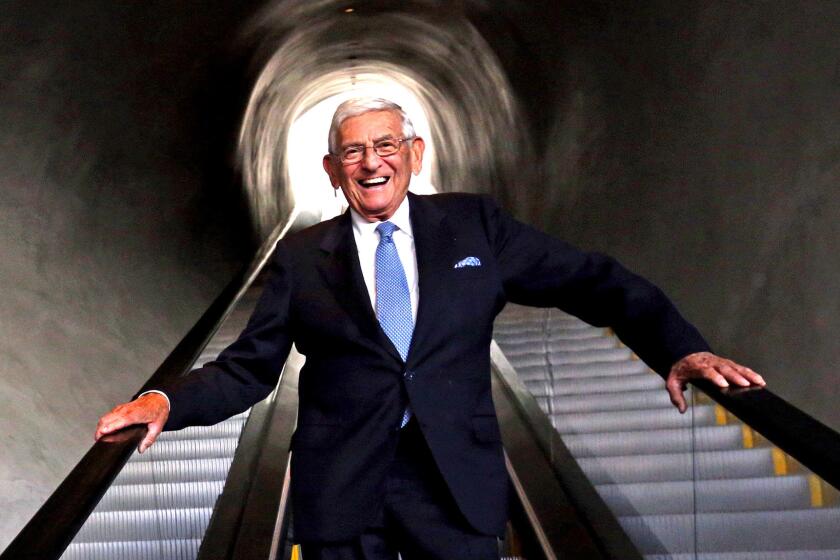Column: Eli Broad was one of L.A.’s most important architectural patrons. He was also one of its most difficult

- Share via
It seems unlikely that a home builder whose big claim to fame is carpeting the Southwest with cookie-cutter tract houses would become one of L.A.’s most important architectural patrons. But Los Angeles is the kind of city where the most beautiful road in town is named for a water engineer, so perhaps it shouldn’t be entirely surprising. (See: Mulholland Drive.)
Eli Broad, who died Friday at the age of 87, was a relentless shaper of the L.A. landscape — as a developer, insurance magnate, political patron, art collector and power broker. And his influence extended to architecture. Over the course of his life, he helped bring to fruition — in whole or in part — designs by an array of award-winning international design stars, including Richard Meier, Renzo Piano, Diller Scofidio + Renfro and, most famously, Frank Gehry. Or perhaps most infamously, because Broad’s relationship with Gehry was, well, fractious.
LACMA, MOCA, the Hammer — museums had a complicated relationship with Eli Broad. Which partly explains why he ultimately built his own.
In the late 1980s, Broad asked Gehry to design a house for him in Brentwood. Gehry accepted the commission on the basis that Broad would not set limits, nor impose a budget. Within two years, Broad had grown impatient with the slow pace — so he took Gehry’s working drawings and had the firm of Langdon Wilson build out the design. Gehry disowned the house and promised never to set foot in it.
Later, in the 1990s, the two came to a head once again. When construction on Gehry’s Walt Disney Concert Hall stalled in the late 1990s, Broad helped take charge of the $135-million fundraising campaign. He also tried to speed things along by taking the job of creating working drawings from Gehry’s firm and giving the job to another studio. (No small gesture — since it’s in the working drawings that the details of a building come into focus.)
Gehry threatened to walk, and Diane Disney Miller, a key member of the Disney clan, backed him up. Broad backed down. And eventually, he and Gehry made amends.
At a private celebration prior to the opening of Disney Hall, Gehry toasted Broad’s efforts on behalf of the building. “All of you have heard about the problems Eli and I had, but look at what we made,” he said. “We’re both control freaks of different types and we collided.”
Broad stated in response, “All I want to say is Frank was right.”

In the case of Disney Hall, the story ended well. Gehry’s ebullient building, clad in a shimmering, stainless-steel skin, was hailed as “the most gallant building you are ever likely to see” by New York Times critic Herbert Muschamp. In the Los Angeles Times, then-architecture critic Nicolai Ouroussoff described it as a “sublime expression of contemporary cultural values.”
But both of these episodes speak to the kind of architectural patron that Broad was for Los Angeles: important by virtue of his wealth and his power, if not always a determination to get the design right.
Broad funded the work of important Pritzker Prize winners: Meier’s design for the Eli and Edythe Broad Art Center at UCLA and Piano’s Broad Contemporary Art Museum on the campus of the Los Angeles County Museum of Art. But as former Times architecture critic Christopher Hawthorne noted in a 2010 critique for this publication, if the collected buildings “have any common thread … it is disappointment: Broad has collaborated with some of the most talented firms in the world, to be sure. But he has also overseen some of their least impressive work.”
To the Broad museum, designed by Diller Scofidio + Renfro, Hawthorne gave a mixed review. The facade was “oddly inert” with little “lightness or translucency,” he noted. “This is no small imperfection in a building whose exterior draws so much of its architectural power from pattern and material texture as opposed to form.”

None of this was aided by the museum’s installation when it opened. Broad quite famously demanded nearly an acre of column-free space on the third floor — which he then promptly got around to filling with a labyrinth of overstuffed galleries that never provide the viewer with a sense of the room’s breadth and scale. It was as if he wanted to check off the talking point — I’ve got column-free space! — without considering what that might mean in practice.
It seems a good deal of this mixed architectural legacy is due to the fact that Broad collected architecture the way he collected art: through the accumulation of names that could be used to burnish reputation, not necessarily for the thrill of an aesthetic quest. One architect once described long conversations with him about the price of light fixtures.
Eli Broad, a billionaire philanthropist and art collector, played a central role in building such Los Angeles institutions as Walt Disney Concert Hall and the Museum of Contemporary Art before building his own museum, the Broad.
His museum reflects these tendencies, especially in the rooms full of auction-house stars that hail overwhelmingly from New York. But the building, which before the pandemic had become an unlikely social spot on dreary Grand Avenue, nonetheless manages some architectural thrills: that escalator ride that punctures the floor plates, the all-glass elevator that feels just a little bit sci-fi. The legacy Broad leaves behind is complicated. But it’s not without its moments of grace.
More to Read
The biggest entertainment stories
Get our big stories about Hollywood, film, television, music, arts, culture and more right in your inbox as soon as they publish.
You may occasionally receive promotional content from the Los Angeles Times.













